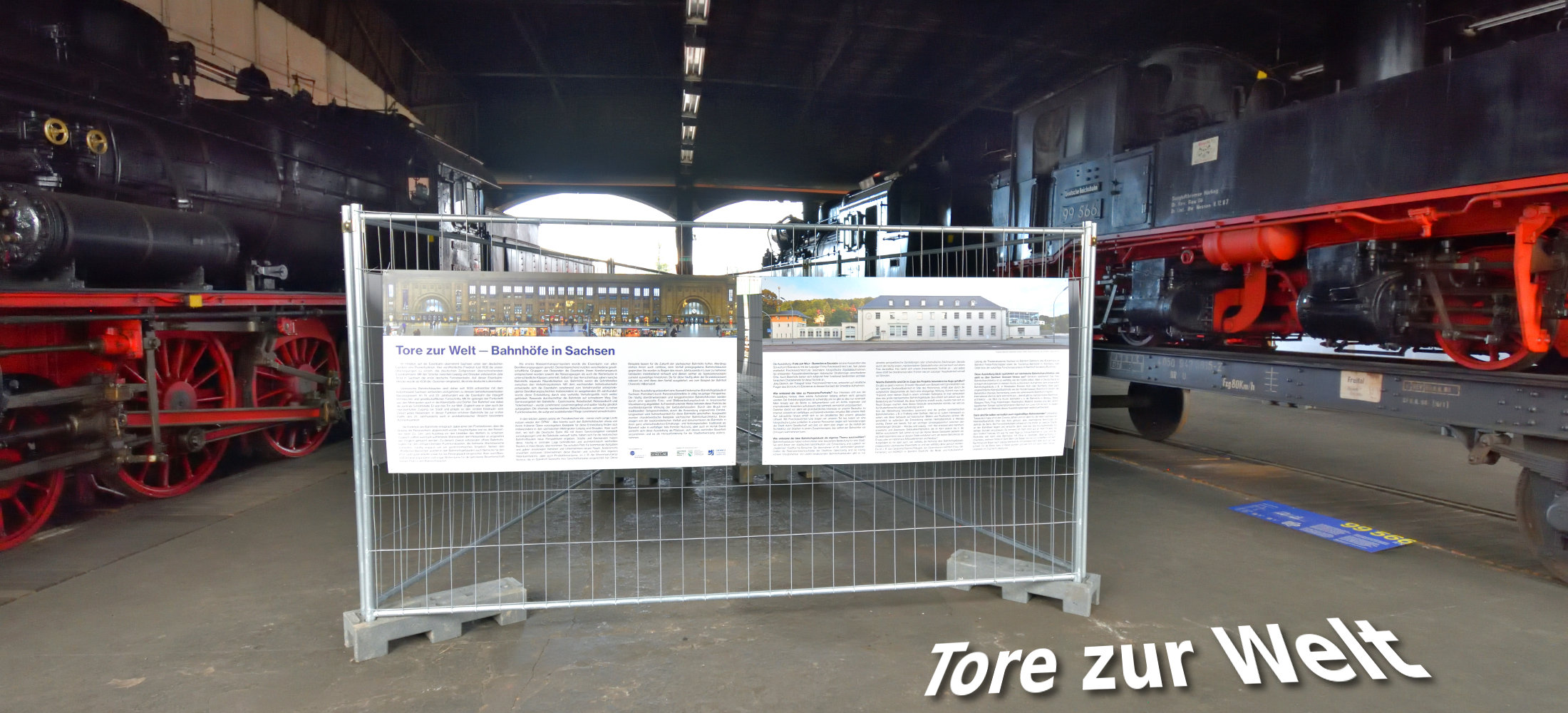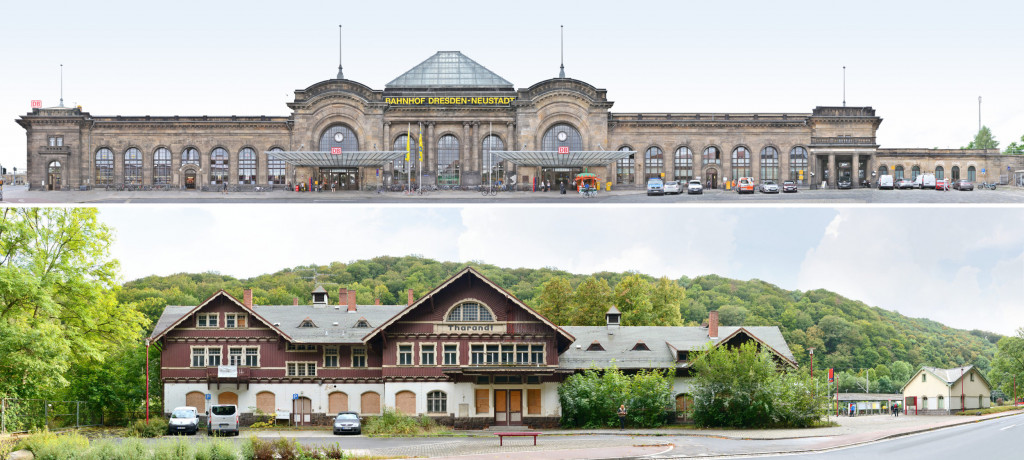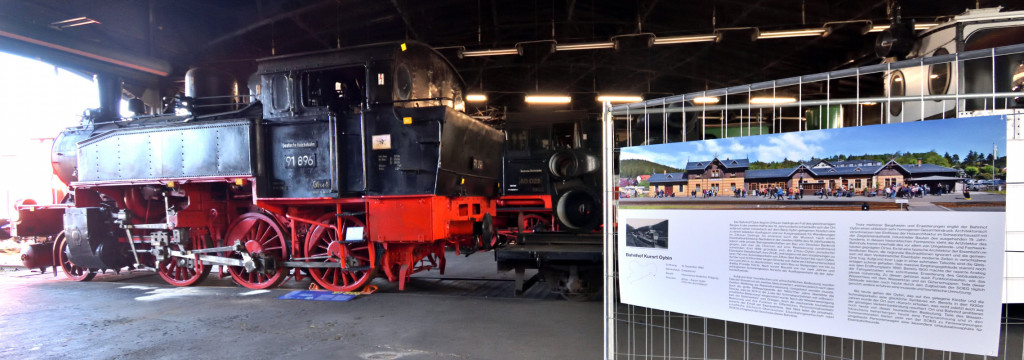An exhibition at the Schauplatz Eisenbahn (railway museum) in Chemnitz-Hilbersdorf
We invite you to visit our joint exhibition “Gates to the World” from April to October 2022 in the locomotive shed of the Chemnitz Railway Museum. Information on how to get there, opening hours and prices can be found on the Schauplatz Eisenbahn website.
The exhibition was created as a cooperation between PanoramaStreetline and Schauplatz Eisenbahn with support from the Cultural Foundation of the Free State of Saxony and the City of Chemnitz.
Train Stations Dresden Neustadt and Tharandt
“Tore zur Welt” (Gates to the World) takes a focused look at Saxon railway station buildings. Saxony has been a pioneer of railways in the German-speaking world ever since Friedrich List’s plans in 1832 and the first long-distance railway “Leipzig – Dresden” in 1839. The railway brought industrialisation to central Germany and brought progress from the metropolises to the small towns and villages of Saxony. At that time Saxony became one of the most densely populated regions in Europe and for every small town its railway station became the gateway to the world. In this function, railway stations also received special attention in architectural terms until the first half of the 20th century.
Train Station Freiberg / Sachsen
Initially, the function of the railway stations corresponded to that of the postal stations, which had previously been used to handle passenger traffic. The main task was to protect passengers from bad weather when boarding, transferring and disembarking. At the same time, any waiting times were to be made as pleasant as possible for the traveller. For this purpose, open station halls with the corresponding functional buildings were built, which provided heated waiting areas, often supplemented by a gastronomic offer. In addition to the public areas, areas were also created in the station buildings for postal and goods traffic, for luggage, but also offices and administrative rooms as well as living quarters for the upper-ranking civil servants.
Train Station Werdau
Towards the end of the 20th century, railway stations increasingly lost their significance. Beyond the stations in the big cities, gastronomy, the character of a place to stay and even the railway service in the buildings were neglected. The railway sold a large part of its station buildings. Cities and municipalities took over ownership of these buildings, which were often centrally located and architecturally valuable. They created space for municipal tasks and gave new space to resident associations and businesses. In other places, exclusive companies acquired these buildings and created their own representative but also production spaces, such as the watch manufacturer Nomos, which set up its business premises in Glashütte station. These examples give hope for the future of Saxon railway stations. However, there are also countless station buildings that have fallen into disrepair, and there have been demolitions in Hohenstein-Ernstthal, Aue, Burgstädt and Meerane, among others. The station building in Werdau shown above has been due for demolition for 8 years and its future is still uncertain.
Train Station Geithain
Our exhibition “Gates to the World” presents a selection of historic railway station buildings in Saxony. The buildings were portrayed by our team in multi-perspective and thus completely new perspectives. The often oversized and elongated station fronts are depicted in linearised visualisation by our special photo and image processing technique. In an impressive way, these portraits emphasise the cityscape-defining effect of the building facades. Characteristic examples of Saxon railway station architecture were selected. These bear witness to the architectural diversity and document the stations in their very different stages of preservation and use: traditionally as a railway station or in diverse, partly foreign use, but also in decay. For an overview of other railway station architecture, nationally and internationally, take a look at our archive of railway station buildings.
More impressions from the exhibition “Gates to the World – Railway Stations in Saxony”:
Stations from Saxony shown in the exhibition: Dresden Neustadt | Leipzig Hauptbahnhof | Leipzig Bayerischer Bahnhof | Chemnitz Hauptbahnhof | Zwickau Hauptbahnhof | Barthmühle | Freiberg/Sachsen | Oybin | Geithain | Crimmitschau | Werdau | Glashütte | Tharandt | Niederau | Gaschwitz | Flöha | Oschatz | Stollberg/Sachsen | Meissen and Reichenbach im Vogtland
As a supplement to the exhibition, you will soon find an extended look at Saxon railway station architecture, beyond the stations shown in the exhibition, in our article on the architecture of Saxon railway stations.
Ausstellungstafel zum Bahnhof Oybin im Lokschuppen










